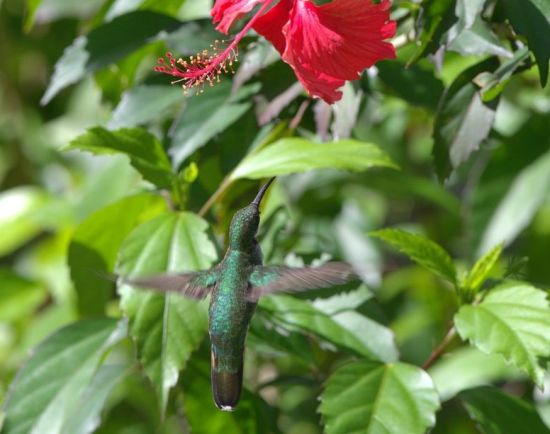(Imp sizes. C/right. Basic tidy-up. Flight picture. Gallery created. References updated) |
(comment to GS) |
||
| (4 intermediate revisions by 2 users not shown) | |||
| Line 1: | Line 1: | ||
| − | [[Image: | + | [[Image:3 Antillean Mango Punta Cana DR 24 1 19.jpg|thumb|550px|right|Photo © by {{user|firecrest15|firecrest15}}<br />Punta Cana, East [[Dominican Republic]], [[West Indies]], 24 January 2019]] |
;[[: Category:Anthracothorax|Anthracothorax]] dominicus | ;[[: Category:Anthracothorax|Anthracothorax]] dominicus | ||
==Identification== | ==Identification== | ||
| − | |||
11–12·5 cm (4¼-5 in)<br /> | 11–12·5 cm (4¼-5 in)<br /> | ||
Both sexes have a black, down-curved bill and green to yellowish-green upperparts.<br /> | Both sexes have a black, down-curved bill and green to yellowish-green upperparts.<br /> | ||
'''Adult male''' | '''Adult male''' | ||
| − | * | + | *Mostly black underside |
| − | * | + | *Green iridescent throat |
| − | * | + | *Central 2 tail is dark with a purple sheen, while the rest of the tail is purple <br /> |
'''Young male''' has a dark stripe centrally on the otherwise white underside<br /> | '''Young male''' has a dark stripe centrally on the otherwise white underside<br /> | ||
'''Female''' | '''Female''' | ||
| − | *Light gray underside that gradually blends in to the green upperside on the side of the head and flanks. | + | *Light gray underside that gradually blends in to the green upperside on the side of the head and flanks |
| + | *Central tail feathers green, the rest are rufous with subterminal black band and white tips. | ||
| + | |||
==Distribution== | ==Distribution== | ||
| − | [[Hispaniola]], | + | [[Hispaniola]] including Île-á-Vache, Tortue, Gonâve and Beata islands. |
==Taxonomy== | ==Taxonomy== | ||
| − | + | This is a [[Dictionary_M-O#M|monotypic]] species<sup>[[#References|[1]]]</sup>. | |
| − | + | ||
| − | + | This species and [[Puerto Rican Mango]] were formerly lumped under the name of Antillean Mango. | |
| − | |||
| − | |||
| − | |||
==Habitat== | ==Habitat== | ||
| − | + | Dry scrub-forest with cactus, open areas and forest edges and gardens, up to 2500 m [[Dictionary_A-C#A|asl]], but rare above 1500. Most frequent in semi-dry areas. | |
==Behaviour== | ==Behaviour== | ||
====Diet==== | ====Diet==== | ||
| − | Consists | + | Consists of nectar and insects. |
====Breeding==== | ====Breeding==== | ||
| − | Nest is a cup with a soft lining of plant fibres, placed in a cactus. | + | Nest is a cup with a soft lining of plant fibres, placed in a tree, shrub or cactus. |
| − | == | + | ====Vocalisation==== |
| − | + | Most frequent is a repeated "tsk" sound, high pitched and sharp. | |
| − | |||
| − | |||
| − | |||
| − | |||
==References== | ==References== | ||
| − | #{{Ref- | + | #{{Ref-Clements6thOct22}}#{{Ref-GillDonskerRasmussen22V12.2}}#Mlodinow, S. G. (2022). Hispaniolan Mango (Anthracothorax dominicus), version 1.0. In Birds of the World (N. D. Sly, Editor). Cornell Lab of Ornithology, Ithaca, NY, USA. https://doi.org/10.2173/bow.antman2.01 |
{{ref}} | {{ref}} | ||
| + | #{{Ref-Kirwanetal19}} | ||
==External Links== | ==External Links== | ||
| − | {{GSearch| | + | {{GSearch| "Hispaniolan Mango"}} |
| + | <!--- Comment to editors: It is on purpose I omitted the scientific name, because we do see some Puerto Rican Mango still having that in their information. ---> | ||
[[Category:Birds]] [[Category:Anthracothorax]] | [[Category:Birds]] [[Category:Anthracothorax]] | ||
| + | {{GS-checked}} | ||
| + | <br /> | ||
| + | <br /> | ||
Latest revision as of 23:07, 20 November 2022
- Anthracothorax dominicus
Identification
11–12·5 cm (4¼-5 in)
Both sexes have a black, down-curved bill and green to yellowish-green upperparts.
Adult male
- Mostly black underside
- Green iridescent throat
- Central 2 tail is dark with a purple sheen, while the rest of the tail is purple
Young male has a dark stripe centrally on the otherwise white underside
Female
- Light gray underside that gradually blends in to the green upperside on the side of the head and flanks
- Central tail feathers green, the rest are rufous with subterminal black band and white tips.
Distribution
Hispaniola including Île-á-Vache, Tortue, Gonâve and Beata islands.
Taxonomy
This is a monotypic species[1].
This species and Puerto Rican Mango were formerly lumped under the name of Antillean Mango.
Habitat
Dry scrub-forest with cactus, open areas and forest edges and gardens, up to 2500 m asl, but rare above 1500. Most frequent in semi-dry areas.
Behaviour
Diet
Consists of nectar and insects.
Breeding
Nest is a cup with a soft lining of plant fibres, placed in a tree, shrub or cactus.
Vocalisation
Most frequent is a repeated "tsk" sound, high pitched and sharp.
References
- Clements, J. F., T. S. Schulenberg, M. J. Iliff, T. A. Fredericks, J. A. Gerbracht, D. Lepage, S. M. Billerman, B. L. Sullivan, and C. L. Wood. 2022. The eBird/Clements checklist of Birds of the World: v2022. Downloaded from https://www.birds.cornell.edu/clementschecklist/download/
- Gill, F, D Donsker, and P Rasmussen (Eds). 2022. IOC World Bird List (v 12.2) DRAFT. Doi 10.14344/IOC.ML.12.2. http://www.worldbirdnames.org/
- Mlodinow, S. G. (2022). Hispaniolan Mango (Anthracothorax dominicus), version 1.0. In Birds of the World (N. D. Sly, Editor). Cornell Lab of Ornithology, Ithaca, NY, USA. https://doi.org/10.2173/bow.antman2.01
Recommended Citation
- BirdForum Opus contributors. (2024) Hispaniolan Mango. In: BirdForum, the forum for wild birds and birding. Retrieved 21 May 2024 from https://www.birdforum.net/opus/Hispaniolan_Mango
- Kirwan, GM, A Levesque, M Oberle, and CJ Sharpe. 2019. Birds of the West Indies. (Lynx and Birdlife International Field Guides) Barcalona, Lynx Editions. ISBN 978-84-16728-17-6
External Links
GSearch checked for 2020 platform.




